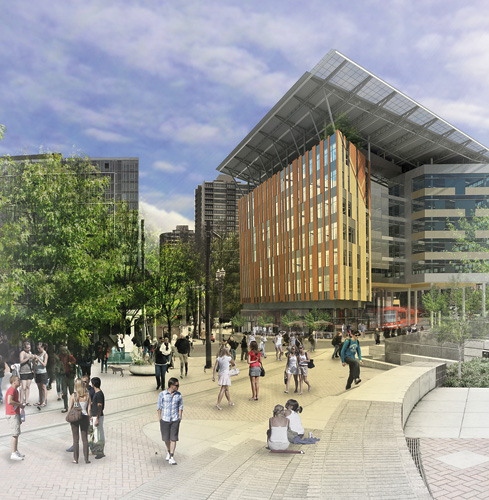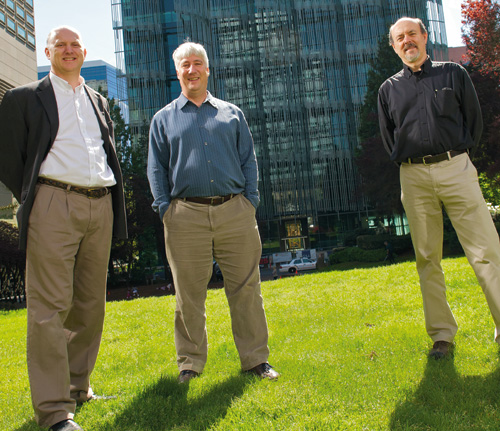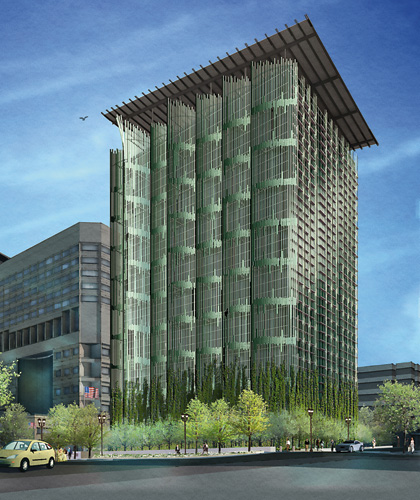 Portland’s SERA Architects prospers by embracing not just sustainability but adaptability.
Portland’s SERA Architects prospers by embracing not just sustainability but adaptability.
BY BRIAN LIBBY
 |
From left: Kurt Schultz, Clark Brockman and Tim Smith head SERA’s architectre, sustainability and planning teams. The Edith Green-Wendell Wyatt building in Portland is in the background.// Photo by Eric Näslund |
Ten years ago architect Clark Brockman and his wife took a year off to bicycle through Asia, a “bucket-list” experience that changed his career outlook. When he returned to Portland, Brockman wanted to make a difference. “I knew that meant sustainability,” he recalls. When he began looking for a firm to join, “It was clear SERA was the greenest firm in town, and I wanted to help grow that.”
Brockman arrived in 2002 amid a wave of change at the firm. First, there was a generational transition: founding partners George “Bing” Sheldon and Don Eggleston were beginning to think about retirement. Instead of selling the company, they created an employee stock option program. The move gave employees a sense of ownership — figuratively and literally, helping Portland-based SERA attract and retain talent. As Brockman came on board to head a new sustainability team, two more principals — Tim Smith and Kurt Schultz — had also recently been hired to oversee planning and architecture. SERA even had a new headquarters in the works: a renovated storefront in Old Town teeming with natural light. The project was designed in accordance with ecological principles laid out by The Natural Step, an environmental education nonprofit. It seemed to represent the marriage of Sheldon and Eggleston’s focus on renovations (including Portland’s City Hall) and the new commitment to sustainability.
The Great Recession, with real estate at the center of its storm, has been especially unkind to architects. Yet even in the darkest days of 2008 and 2009, when virtually no architecture firm in the city had much new business, SERA never laid off employees. The staff collectively decided on furloughs and pay cuts. Today its staff of 114 is nearly triple what Brockman encountered in 2002.
SERA is involved in some of the highest-profile work in Portland, such as the Oregon Sustainability Center (in collaboration with Portland firm GBD Architects), the Edith Green-Wendell Wyatt federal building downtown, a new Central City Concern facility on Broadway, and the upcoming Collaborative Life Sciences complex (with California’s CO Architects) for Oregon Health & Science University in the South Waterfront district. Those are all public projects, a ray of hope to many firms when the condo bubble burst. But the firm is also busy in other regions such as China and the Middle East where economies continue to grow. SERA worked on the creation of Liwa, a whole city from scratch in the United Arab Emirates.
After surviving all that early in the 2000s, SERA’s leaders came to believe there was a competitive advantage in a culture of continuous adaptation to change and suppressing ego. “We’re the opposite of a ‘starchitect’ firm,” says Schultz. “We want as many smart people in the room as we can.”
 |
SERA co-designed an innovative new energy-saving shaded facade to transform the circa-1974 Edith Green-Wendell Wyatt federal building. |
The trio of principals and the broader SERA team also share a belief that architects are providers of service rather than product. “Not every solution presented as an architectural problem is necessarily one that should result in a new building,” Smith says. “Sometimes it’s a decision not to grow, or to renovate. The biggest value we give to clients is strategic advice how to think their way out of a problem.”
For example, on the Green-Wyatt federal building co-designed with acclaimed Bainbridge Island architect James Cutler, Cutler is the more famous name, but SERA is the reason a massive government project with all the accompanying red tape will finish construction more than a year early and use less than half the energy or water of a comparable office building. The firm even permanently located an employee at the building site, something usually unheard of for architects. “There was never a challenge, a change or a constraint that they responded to with excuse or irritation,” says Pat Brunner of the General Services Administration, the entity supervising the Green-Wyatt project. “Every problem was an opportunity to excel.”
Taking a cue from Sheldon and Eggleston, the succeeding generation at SERA also get involved in public policy, regularly sitting on government panels and volunteering in the community, which in turn can lead to business, as when a casual discussion over drinks with the Portland Development Commission about the then-soon-to-be vacated (and seismically unstable) Meier & Frank building led to an innovative public-private partnership with the Nines Hotel ultimately moving in.
A few years later, the hotel’s local developer hired SERA to design another downtown hotel that became the first LEED-certified property in the Marriott chain. Now the firm is working on Marriott hotels in the Pearl District, South Waterfront and Denver, all as a result of spearheading innovation at Meier & Frank. There are also new condos planned for Northwest 23rd Avenue, a 16-story student-housing complex at Portland State University, affordable housing in Sacramento, and a major renovation of the Oregon Department of Transportation headquarters in Salem.
“We’ve gotten more conscious about noticing trends and trying to identify them early and participate,” Brockman says. “Many times the job is not what you thought it would be the week before. That’s easier to implement for a firm used to constant change.”
Brian Libby is a Portland journalist. Reach him at [email protected].


